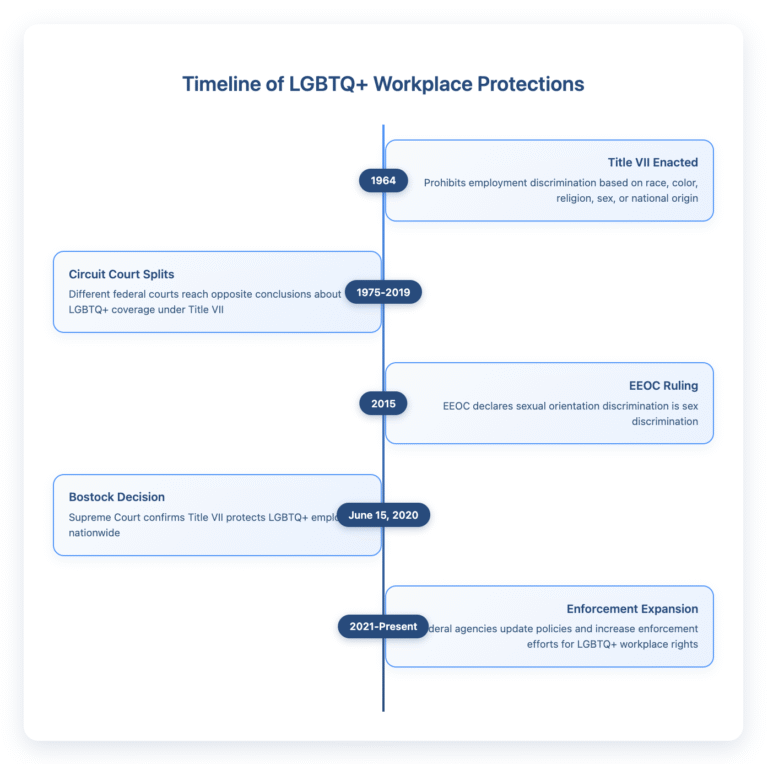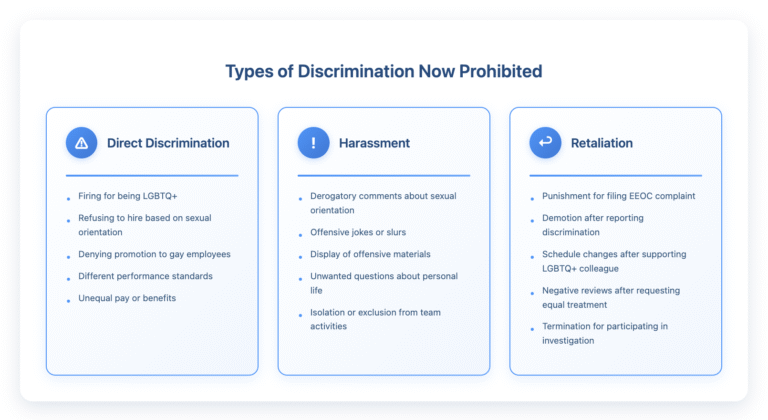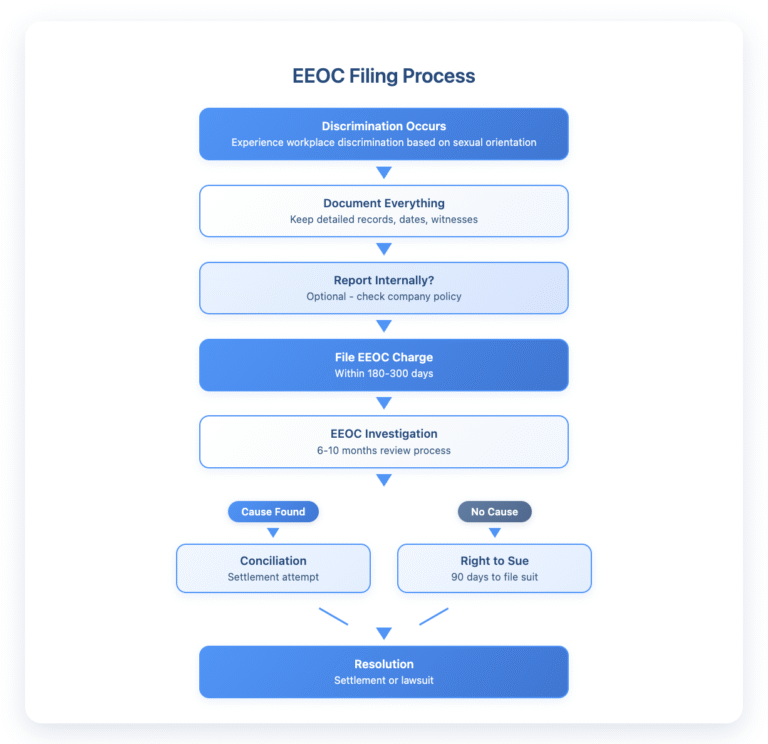If you’ve been discriminated against at work because of your sexual orientation or gender identity, federal law now protects you. The Supreme Court’s landmark Bostock v. Clayton County decision fundamentally changed workplace rights for LGBTQ+ employees across America. Here’s what this means for you and how to use these protections if you need them.
Before June 15, 2020, whether you had legal protection against workplace discrimination depended entirely on where you lived. Now, Title VII of the Civil Rights Act protects you nationwide, regardless of state or local laws.
Disclaimer: This article provides general information for informational purposes only and should not be considered a substitute for legal advice. It is essential to consult with an experienced employment lawyer at our law firm to discuss the specific facts of your case and understand your legal rights and options. This information does not create an attorney-client relationship.
Understanding the Bostock Decision
The Supreme Court ruled 6-3 that firing someone for being gay or transgender violates Title VII’s prohibition on sex discrimination. Justice Gorsuch wrote that it’s “impossible to discriminate against a person for being homosexual or transgender without discriminating against that individual based on sex.”
This wasn’t just legal theory – it came from real people facing real discrimination. Gerald Bostock was fired from his job as a child welfare advocate in Georgia after joining a gay softball league. Donald Zarda, a skydiving instructor, lost his job after mentioning his male partner. Aimee Stephens was terminated from a funeral home after informing her employer about her gender transition.
What Makes Bostock So Powerful
The Court’s logic is straightforward and hard to argue against. If an employer fires a male employee for dating men but wouldn’t fire a female employee for the same reason, that’s sex discrimination. The employer’s action depends on the employee’s sex – exactly what Title VII prohibits.
This reasoning applies to all forms of sexual orientation and gender identity discrimination, not just termination. It covers hiring, promotions, job assignments, benefits, and any other term or condition of employment.

How Title VII Protection Actually Works
Title VII applies to employers with 15 or more employees, including private companies, state and local governments, employment agencies, and labor organizations. If your employer meets this threshold, you’re covered.
The protection extends beyond just keeping your job. It means your employer can’t:
- Refuse to hire you because of your sexual orientation
- Pay you less than similarly situated straight employees
- Deny you promotions or training opportunities
- Subject you to different terms or conditions
- Create or tolerate a hostile work environment
- Retaliate against you for reporting discrimination
Recognizing Illegal Discrimination
Not every negative workplace experience constitutes illegal discrimination. The key question is whether your sexual orientation played a role in the adverse action. Sometimes this is obvious – like when a supervisor says they “don’t want gay people on the team.” More often, it’s subtle.
Look for patterns and timing. Did problems start after you mentioned your same-sex partner? Are LGBTQ+ employees consistently passed over for promotions? Do inappropriate comments go unaddressed while similar behavior toward other protected groups gets punished?

Building Your Discrimination Case
If you’re experiencing discrimination, documentation becomes your best friend. Start keeping detailed records immediately, even if you’re not sure you’ll take legal action.
Write down dates, times, locations, and everyone present for each incident. Save all relevant emails, texts, and other communications. If your company uses messaging apps like Slack or Teams, take screenshots before messages disappear.
Essential Documentation Checklist
Keep records of:
- Every discriminatory comment or action, no matter how small
- Your job performance reviews and commendations
- Communications showing different treatment compared to straight colleagues
- Any complaints you’ve made and the responses (or lack thereof)
- Changes in your treatment after coming out or being outed
- Witnesses who saw or heard discriminatory behavior
Don’t wait for a “smoking gun” email saying “I’m firing you because you’re gay.” Courts understand that discrimination today is rarely that blatant. They’ll look at all the circumstances together.
The EEOC Process: Your Federal Remedy
Before you can sue under Title VII, you must file a charge with the Equal Employment Opportunity Commission (EEOC). You typically have 180 days from the discriminatory act, though some states extend this to 300 days.
Filing with the EEOC doesn’t mean you’re suing – it starts an investigation process. The EEOC will notify your employer and may attempt mediation. If they find reasonable cause to believe discrimination occurred, they’ll try to reach a settlement.
What Happens After Filing
The EEOC process follows predictable steps:
- Charge filing: You submit your complaint with supporting information
- Employer notification: Your employer receives notice and responds
- Investigation: EEOC reviews evidence from both sides
- Determination: EEOC decides if there’s reasonable cause
- Conciliation: If a cause is found, EEOC tries to settle
- Right to sue: If the settlement fails, you get a letter allowing you to file a lawsuit
This process can take months or even years. But filing preserves your rights and may lead to a resolution without litigation.

State and Local Protections Still Matter
While Bostock provides a federal floor for protection, many states and cities offer additional rights. New York, for example, covers employers with fewer than 15 employees and provides longer filing deadlines.
Some jurisdictions explicitly protect gender expression and provide broader remedies. Don’t assume federal law is your only option – you might have stronger claims under state or local law.
Comparing Your Options
Federal, state, and local laws each have different:
- Filing deadlines
- Employer size requirements
- Available damages
- Procedural requirements
- Standards of proof
An experienced employment attorney can help you understand which laws provide the strongest protection for your situation.
Practical Strategies for Protection
Even with Bostock’s protections, preventing discrimination is better than remedying it. If you’re comfortable being out at work, consider these protective steps:
Get it in writing: When possible, communicate important matters via email. If you have verbal conversations about performance or workplace issues, follow up with an email summarizing what was discussed.
Build your network: Maintain good relationships with colleagues who can serve as witnesses if needed. Their observations can corroborate your experiences.
Know your employee handbook: Understand your company’s anti-discrimination policies and complaint procedures. Follow them when appropriate, but remember that internal complaints don’t replace EEOC filing deadlines.
Keep personal copies: Store important documents (performance reviews, commendations, disciplinary actions) outside your workplace. You might lose access to company systems suddenly.
When Retaliation Becomes the Issue
Retaliation claims often succeed even when the underlying discrimination claim doesn’t. If you report discrimination and then face negative consequences, that’s illegal – even if the original discrimination can’t be proven.
Retaliation can be subtle. It might look like:
- Sudden negative performance reviews
- Exclusion from meetings or projects
- Shift changes that affect your personal life
- Increased scrutiny of your work
- Cold shoulder treatment from management
Document any changes in treatment after you complain about discrimination. The temporal connection between your complaint and the adverse action can establish retaliation.
Recent Developments and Enforcement Trends
Since Bostock, federal agencies have strengthened LGBTQ+ protections. The EEOC has prioritized sexual orientation and gender identity cases, securing significant settlements and court victories.
Courts are applying Bostock broadly. The decision’s logic extends beyond employment to other areas of federal law prohibiting sex discrimination, though employment remains the clearest application.
Notable Post-Bostock Cases
Several cases have clarified Bostock’s reach:
- Courts have confirmed that Bostock covers discrimination based on gender expression and nonconformity
- Benefits discrimination against same-sex spouses violates Title VII
- Bathroom and dress code policies targeting transgender employees can constitute discrimination
- Hostile work environment claims based on sexual orientation are valid under Title VII
Common Employer Defenses (And How They Fail)
Employers often raise predictable defenses to discrimination claims. Understanding these helps you prepare your case:
“It wasn’t about sexual orientation”: Employers claim other reasons for adverse actions. That’s why documenting your good performance and comparing treatment to straight colleagues matters.
“We didn’t know”: Some employers claim ignorance about an employee’s sexual orientation. But discrimination can occur based on perception or assumptions, even if incorrect.
“Religious freedom”: While religious organizations have some exemptions, most employers can’t use religious beliefs to justify discrimination. The law generally doesn’t permit religious views to override civil rights protections.
“Customer preference”: Employers can’t discriminate because customers might prefer straight employees. Customer bias doesn’t excuse employer discrimination.
Taking Action: Your Next Steps
If you’re facing sexual orientation discrimination at work, you don’t have to navigate this alone. Here’s your action plan:
- Document everything immediately – Start your record-keeping today, even for past incidents you remember
- Review your employee handbook – Understand internal policies and whether you need to report internally
- Calculate your deadlines – Mark your calendar for EEOC filing deadlines
- Gather your evidence – Collect emails, performance reviews, and identify witnesses
- Consider legal counsel – An attorney can evaluate your case and protect your rights
Making the Decision to Act
Deciding whether to pursue a discrimination claim is personal. Consider your goals – do you want to keep your job, receive compensation, or change company practices? Think about your emotional resources and support system.
Remember that the law prohibits retaliation, but that doesn’t mean it won’t happen. Have a financial cushion if possible, and be prepared for a potentially long process.
Protect Your Rights with Experienced Legal Counsel
The Bostock decision gave LGBTQ+ employees powerful federal protection, but enforcing these rights requires understanding complex legal standards and procedures. Missing a deadline or failing to properly document discrimination can sink even the strongest case.
If you’re experiencing sexual orientation discrimination at work, don’t wait until it’s too late. The attorneys at Nisar Law Group understand both the legal complexities and the personal challenges you’re facing. We can evaluate your situation, explain your options, and help you protect your career and dignity.
Contact Nisar Law Group today for a consultation. We’ll review your case, explain your rights under federal and New York law, and develop a strategy tailored to your goals. You’ve gained important federal protections – now make sure you can use them effectively.
Remember: EEOC deadlines are strict, and evidence can disappear quickly. The sooner you seek legal guidance, the stronger your position. Reach out to Nisar Law Group to discuss how we can help protect your workplace rights and ensure you’re treated with the respect and fairness you deserve.


